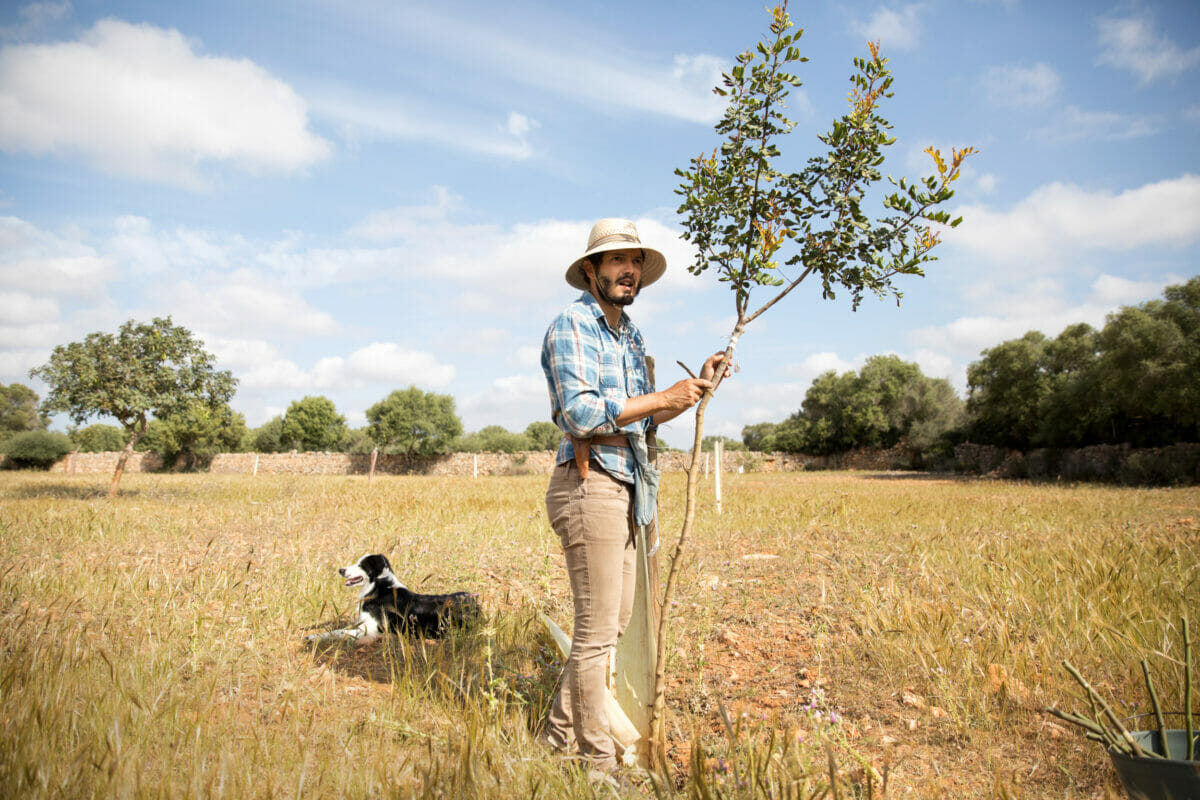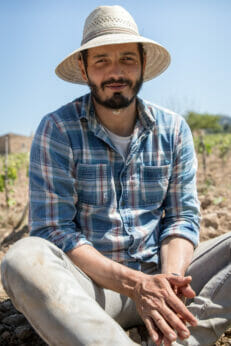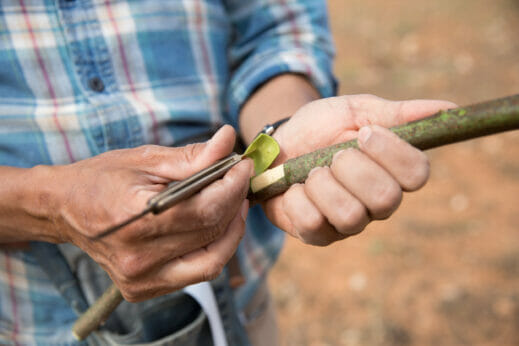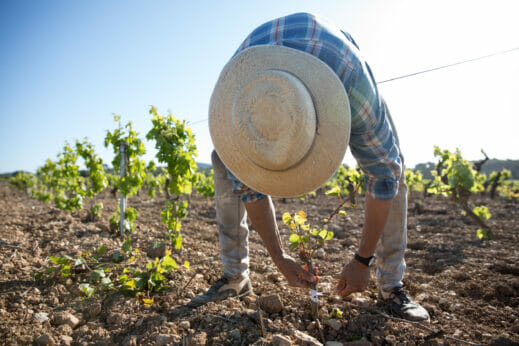One of the youngest men taking on this ancestral practice on the Spanish island, Pere Sureda uses his knowledge of grafting to propagate traditional fruit varieties and preserve local heritage.

Pere Sureda describes himself as a “spreader of biodiversity.” As a grafter, his technical knowledge and dexterity is helping small producers rescue and preserve traditional local varieties that once dotted the Majorcan countryside, such as Duraió and Bugadera carob trees, Frare Llarg and Frare Verd plum trees and Garta Vermella apricot trees.
Majorca, the biggest of the Balearic Islands, in the Mediterranean Sea, has a long history with trees but also with the art and science of grafting. This horticultural practice is used to join together two separate plants, usually within their own species. Growing as one, they combine the resilience of the one rooted to the soil, called rootstock, with the fruiting qualities of the bud or shoot that is inserted into it.
“In my view, grafting is partly mechanical and partly magical,” says Sureda, as he cuts buds from the twig of a vine in preparation for grafting them. “You take a portion of a plant and add it to another one. [The fruit that grows is] turned into wine that is valued all over the world.”

Pere Sureda. Photography by Angeles Rodenas.
Applied on the island for more than four hundred years, the technique kept local fruit trees and grapevines alive during the phylloxera plague and, more recently, it is helping to preserve olive and almond varieties that have escaped the Xylella fastidiosa disease. Less than a century ago, there would be several people in each Majorcan village performing the task of grafting, but after the boom in the tourism industry in the 1950s and the stampede to more lucrative jobs in urban areas, land was left unattended and skills were lost. Today, the responsibility of grafting lies with just a handful of professionals. At 39, Sureda is one of the very few people on the island, and possibly the youngest, that has taken on the responsibility of grafting. However, he doesn’t see it as such. “I propagate local varieties,” he says, “but the responsibility of preventing them from disappearing lies with the farm owners,” with whom Sureda works closely.
Sureda studied history and environmental management in Barcelona, returning home to an old family farm in the east of Majorca. There, he researched the recovery of traditional seeds before retraining as a pruner and then as a grafter because he “wanted to work in direct contact with the land,” away from the confines of an office and a desk.
The bulk of his grafting duties are carried out in the spring and autumn at small farms, but during less busy periods, he is able to take requests from locals eager to preserve varieties, such as plum and apricot trees, rooted in the family orchard for generations. If not grafted and multiplied, the trees will eventually naturally die and the variety will quite likely disappear. With the average farm in Majorca clocking in at just 0.72 hectares, small properties form the fabric of the landscape. What happens to small farms shapes the island’s identity. For a countryside that is struggling to survive against a voracious tourism industry, preserving local varieties means keeping local biodiversity and cultural knowledge alive.

Photography by Angeles Rodenas.
Grafting is in particularly high demand in an iconic tree in the Majorcan landscape, native to the Mediterranean area and Middle East: carob. The price of this small fruit peaked last year at 1.55 euros per kilo ($1.37), four times its price in 2018, although it is now sharply falling. Spain is one of the largest global producers of carob and in Majorca neither grafters nor nursery growers were able to meet the demand for the tree at the height of the craze.
Against this backdrop, Sureda has been working with carob plantation owner Xisco Llompart to focus on genetic variability, rather than maximizing the harvest. Llompart’s property is located in the driest area of the island. He has commissioned Sureda to graft half of his plantation in an effort to boost genetic diversity. Current research suggests that trees with broader genetic makeup are more naturally protected against infection, so Llompart and Sureda are using the carob grove as a test plot. However, Sureda says, disease prevention is not that straightforward. “Grafting doesn’t prevent disease. If you take a bud or shoot from a diseased plant, you will also multiply the disease in the graft,” he warns.

Photography by Angeles Rodenas.
Weather permitting, Sureda will start grafting olive trees in April. In May, he helps octogenarian organic winegrower Guillem Sureda and his son Tony to graft the native grape varieties callet, manto negro and fogoneu that, once harvested, will produce young wines. The vineyard is close to his heart, as it is here where Sureda learned to do the chip budding on vines five years ago. It is a backbreaking method performed close to the base of the rootstock, which involves unearthing the rootstock, inserting a bud with a sliver of wood on a matching notch close to the roots, locking the graft with string and covering it again. “If someone ties up the grafts after me, I can do up to 500 a day,” says Sureda. The hard work has paid off; the latest season has had a 99% success rate.
Along with grafting and pruning, Sureda also teaches aspiring growers his craft in order to make a living throughout the year. Following his own mentors, such as Bernat Ramis, one of the most experienced professional grafters on the island, Sureda has amassed a unique knowledge and has adopted a magnanimous approach to it. “I don’t keep anything to myself,” he says. “I try to be as generous with others as people have been with me.”
THANK YOU, ANGELES RODENAS and I’m glad to see Modern Farmer getting back into the urgent business of our planet’s survival, away from cutesie “issues.” The carob tree is the future, providing excellent nutrition from the poorest of soils, grafting an essential skill for the furure of all vine + tree crops. GO MOD FARMER. rlgordonjr@hushmail.com
I like to explore biology a lot because it has many interesting things.